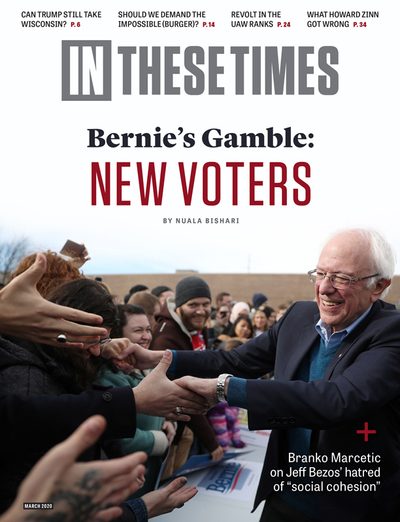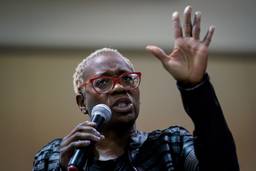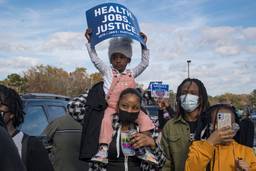Bernie’s Strategy To Win California—And Everywhere
Sanders is taking a risk no one has before: banking on new voters
Nuala Bishari
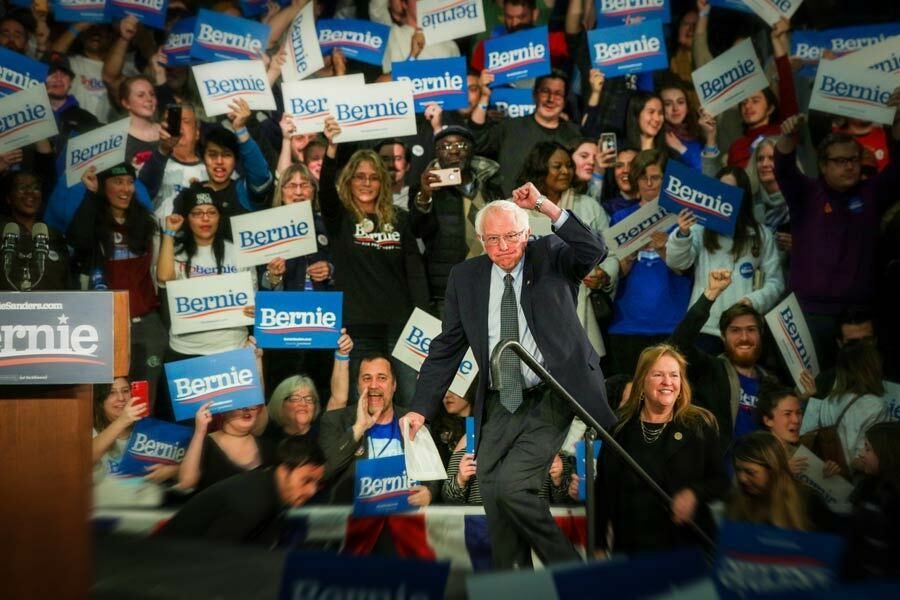
Vermont Sen. Bernie Sanders emerged by early 2020 as the Democratic presidential frontrunner, finishing in the top two in the Iowa caucus (with Indiana Mayor Pete Buttigieg, as of press time) and in national polls (with former Vice President Joe Biden). Sanders’ strategy, which distinguishes him from his opponents and breaks with the traditional Democratic playbook, is deceptively simple: Convert nonvoters with a powerful message.
“We need to appeal to young people and disenfranchised working-class people who are giving up on the political process,” Sanders told rallygoers in Iowa City on January 12. “That’s the way we’re going to beat Trump.”
Or, as Sanders campaign surrogate Rep. Alexandria Ocasio-Cortez (N.Y.) told a Las Vegas crowd: “The swing voters that we’re most concerned with are the non-voters to voters. What we need to communicate is that this, this year — for two days, your primary and the general — it’s worth it to believe.”
President Barack Obama employed a similar strategy in 2008, turning out a record number of first-time voters, who were disproportionately young, lower-income and non-white. Sanders hopes to grow the electorate further by targeting the marginalized, working-class groups that can relate to his policies, groups seldom targeted by presidential candidates.
The gamble is risky: Getting low-frequency voters to the polls is time-consuming and expensive. People must first be convinced that Sanders is worth it, then register to vote in their primary — and then actually show up. But Sanders believes these voters are the Democrats’ only chance to secure the 46th presidency in November.
The Iowa caucus results lend credibility to the idea, with some reservation. Sanders, like Buttigieg and Sen. Elizabeth Warren (Mass.), spent heavily in Iowa, but the Sanders campaign put special effort into reaching working-class communities. Sanders canvasser Melissa Tandiwe Myambo, for example, a U.S. citizen who grew up in southern Africa, says that until the final two days, she saw no other campaign at the largely Sudanese Iowa City apartment complex she worked.
Sanders ran away with nearly half of caucusgoers under 30 as young Iowa voters turned out at levels matched only by the 2008 primary, but new voters failed to turn out overall. Entrance polls suggest only 37% of caucusgoers were new (though Sanders grabbed almost a third of them), compared with 44% in 2016 and 57% in 2008.
It’s hard to know how much weight to put on the Iowa results. The state is 91% white and heavily engaged every four years by presidential campaigns. The contests ahead will test whether Sanders can turn out new voters in states with significant populations of Latinos (who heavily favor Sanders) and where working-class voters may never receive another campaign’s knock.
LETICIA ARCE, 29, IS VOLUNTEERING AT A Spanish-language phone bank session January 24 at Sanders’ campaign office in the historically working-class, Latino Mission District of San Francisco. Arce, a tenant- and immigrant-rights organizer, appreciates Sanders’ plan to expand Social Security benefits.
“I work with a lot of people who are getting $900, $1,000 in Social Security, and they’re paying $600, $700 of that toward rent,” Arce says. “A lot of elders need to keep working into their seventies to survive.”
Two of the women Arce brought with her were senior, monolingual Spanish speakers who can’t vote — but are dedicated to turning out Sanders supporters.
“[Sanders’] vision can really move voters who haven’t historically voted,” Arce says. “It’s just a very exciting time and a big opportunity to get people activated.” But there are decades of apathy and disenfranchisement to tackle, too. “People have a lot of pessimism toward voting,” she adds, and many of her phone calls consist of basic civic engagement: What is a primary? Why does California matter? How do you register as a Democrat?
“Oftentimes, when I talk to monolingual Spanish voters, they haven’t been outreached to,” Arce says. “They’re not getting all the phone calls that English voters might be getting.”
Sanders is working to change that, adding more campaign offices and field organizers since 2016. Though his platform certainly hasn’t changed much (Medicare for All, tuition-free college and massive investment in affordable housing remain central planks) his campaign strategy has.
“I think [the Sanders camp was] initially running — and he’s been pretty up-front about this — because someone needed to make the progressive case on that national stage,” says Dan Cohen, a progressive political strategist and pollster not affiliated with the Sanders campaign. “When that’s your goal, you’re a lot less worried about building an infrastructure capable of [winning a primary].”
The so-called nonvoter group Sanders is going after includes the newly eligible young voter, the non-registered voter, the occasional voter and the regular voter who doesn’t primary. These nonvoters are younger, less affluent and less likely to be white. Most make less than $30,000/year.
Reaching these voters costs money and can come at the expense of outreach to more reliable voters. Sanders, the primary’s most successful fundraiser, is using that money to “cast a broad net,” says Chuck Rocha, a senior advisor to the campaign. In the first five primary states, the Sanders campaign began door-knocking almost a year ago, talking with voters to “determine who is most likely to be energized by Bernie Sanders.”
California offers a snapshot of this growth since 2016, expanding three offices in Los Angeles and Oakland to 19 across California, the majority in working-class and Latino neighborhoods. The campaign had the most extensive California ground game until late entrant Michael Bloomberg began pouring money into the state, hiring 220 organizers (to Sanders’ 90) and targeting centrist Latinos. But Sanders got a head start, boasting a half million phone calls and 400,000 doors knocked in the state in 2019.
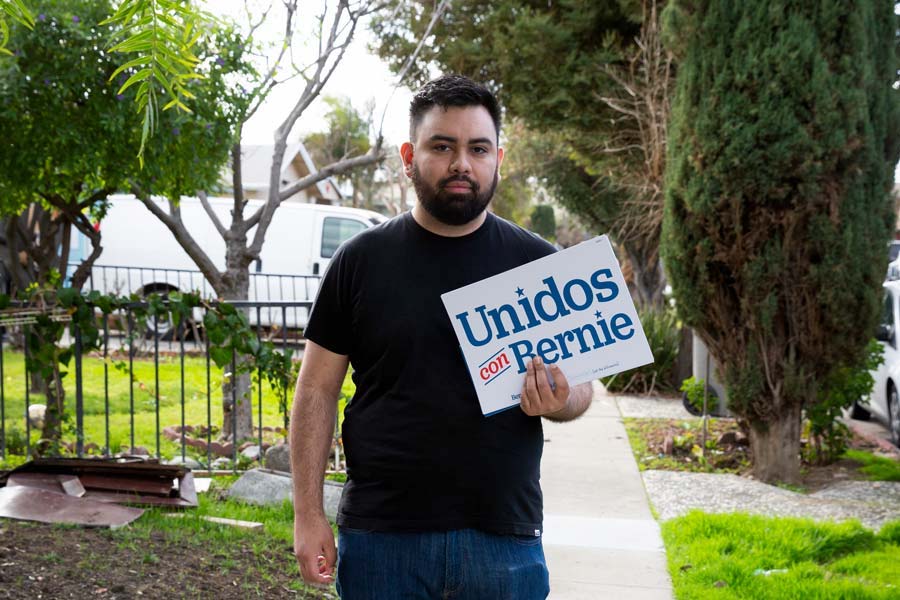
( Ivan Aguilar, 27, a Latino field organizer for the Bernie Sanders campaign, canvasses San Jose, Calif., on January 26. Aguilar, whose parents are immigrants, became politically active because of Sanders’ 2016 presidential campaign. Photo credit: Emma Marie Chiang)
WITH 415 DELEGATES, CALIFORNIA HAS the most of any state. Starting this year, it has bumped its primary from June — so late, its results often did not change the outcome of the race — to the most influential day of the season, March 3, aka Super Tuesday. But California matters to Sanders for more reasons than just momentum.
“California is a state that actually represents this country — it’s not Iowa, it’s not New Hampshire,” says Jane Kim, Sanders’ California political director. “He wants to demonstrate that he can win a diverse state that is rich with Latinx, Asian-Pacific Islander, African American voters and young voters. He believes that that’s his base: working-class voters. Nowhere in the country is the income inequality so stark as it is here in the state, and that’s really what his agenda is based on.”
According to the California Civic Engagement Project, Latinos comprise nearly a quarter of all voter growth in the United States from 1996 to 2016. They make up 21% of California voters. Yet many campaigns invest little in outreach to Latinos.
“They’re never talked to early in a campaign,” Rocha says. “Just at the last minute, with some horribly translated Google ad, and then they’re expected to turn out. There’s never an expansion of the universe. It’s just a halfway effort to try to get the prime voters among the Latino universe out. We’ve turned that on its head.”
Half of Sanders’ California area directors — three of six — are Latino, as is the state director of the campaign, Rafael Návar. According to Návar, primary election outreach efforts in California began in earnest in summer 2019 — with an emphasis on non-party preference voters, particularly in Latino working-class communities. It’s a valuable voter base: A quarter of registered voters in California have not declared a party preference, more than all registered California Republicans. But reaching these voters is not easy. Only rarely have neighborhoods with high concentrations of non-party preference voters heard from presidential campaigns.
“They’re infrequent voters — they might miss midterms, or [might not be] engaged in every election cycle,” Návar explains. “But we know that they would respond favorably to the policies that Sanders puts forward. Our strategy is really focused on talking to these voters and meeting them where they’re at.”
Sanders canvasser Ivan Aguilar’s specialty is in talking with people who may not be interested in politics. Aguilar, 27, began campaigning for Sanders in 2016, but he says there’s more energy from his Latino community this time. At a 2019 Day of the Dead celebration in Oakland, for example, he says a flood of people descended on his Sanders table with questions, turning his four-hour shift into a 10-hour day. The next morning, campaign staffers offered him a position as a field organizer. He quit his job and started knocking on doors.
Aguilar canvassed Meadow Fair on January 26, a predominantly Latino neighborhood in East San Jose. The neighborhood is mostly small, one-story single-family homes, their yards filled with orange trees, cacti and flowers.
“You’re going into neighborhoods that have never been outreached to before,” says Aguilar. “A lot of the people, especially in this area, are apolitical — or they already see Bernie in a good light, and then in that case it’s kind of easy.”
“Buenas tardes,” Aguilar begins at the door, switching to English as needed. When residents are on the fence about voting in the primary, Aguilar launches into his personal story about Sanders.
For Aguilar, that tale begins with the 2008 recession. His father owns a small trucking business and had managed to save enough to buy two small houses in Tracy and Hayward, Calif., but their family lost both homes during the collapse.
“To see their houses be taken away so easily, overnight basically … it really struck me,” Aguilar says. “This affected everyone I knew. I was like, ‘This is not right. Something has to be done.’ ”
“It’s very encouraging,” Aguilar says about the grassroots-level campaign strategy. “In a lot of Latino communities, it’s often the kids who are voting within the household. You go to these houses, you ask for their name, and they greet you with enthusiasm.”
TIME MAGAZINE REPORTS THAT 44 MILLION Americans owe a whopping $1.6 trillion on their student loans, so it’s not surprising that Sanders’ platform of tuition-free public college appeals to young voters. The Center for Information and Research on Civic Learning and Engagement at Tufts University deduced that, during the 2016 primaries, Sanders won more of the youth vote than President Donald Trump and candidate Hillary Clinton combined: Sanders pulled in 2 million ballots from voters 18 – 29, compared with less than 1.6 million. In 2019 he introduced a plan to cancel all $1.6 trillion in U.S. student loan debt.
“The younger generation today is, in my view, the most progressive young generation in the history of this country, and for every three young people who vote, two out of those three will vote progressive,” Sanders told a crowd at Iowa State University in January. “The not-so-good news is that same generation historically hasn’t voted in very large numbers. So tonight [what] I’m saying to that generation is: If you are tired of student debt, if you are sick and tired and scared about climate change, if you are disgusted with racism, and sexism, homophobia and xenophobia, and if you believe that healthcare is a human right, then you can’t sit it out and you can’t complain.”
But Sanders’ youth outreach goes deeper than his platform. In 2019, the campaign launched an organizing boot camp for college-age volunteers called Students for Bernie Summer School, complete with homework and webinars. The Bern mobile app, also launched in 2019, serves as an organizing tool for graduates of the boot camp: Users can identify potential swing voters and log voter information. The technology is simple and familiar for social media users, making it easy to sign up friends, family and neighbors with a few taps and swipes.
Sanders’ young supporters seem to be pressuring their elders. Sanders’ popularity first ballooned among Latino youth, and then the older generation got on board. “The best way I’ve seen to get people out — or even to care at all — is through their children,” Aguilar says. “If they hammer in the message themselves when I’m not there, that really cracks the shell.”
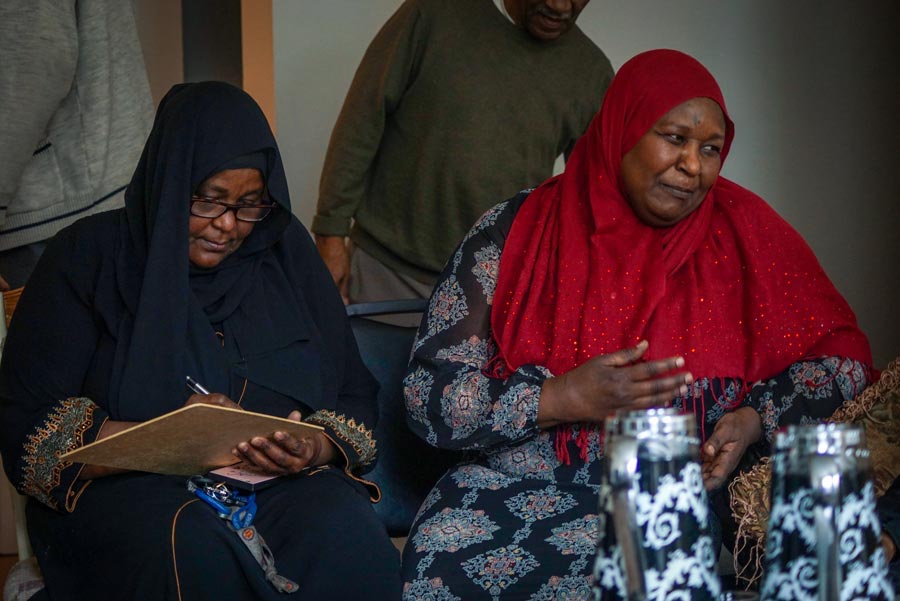
(Sudanese-American voters Thuria Ali Dinar (left) and Amal Mohamed caucus at a satellite location for foreign language speakers in Iowa City. “I voted for Bernie because he fights for pro-immigration and pro-worker policies … for students to have their loans canceled and for health insurance for everyone,” Mohamed says. Photo credit: Juan Manuel Galvez Ibarra)
“WE ARE THE ONLY ONES TAKING RISKS to try and expand the electorate, and the only ones with the infrastructure to take those risks,” says Sanders Iowa field organizer D’Angelo Oberto-Beso.
One such effort is with another growing Democratic base: immigrant voters. A tenth of eligible 2020 voters was born outside the U.S., the highest proportion since 1970. This group will have an opportunity to vote out a sitting president known to describe immigrants with words like “invasion” and “killer,” who has said he is “seriously” considering abolishing birthright citizenship, and who has even told four elected U.S. congresspeople to “go back” to the “crime-infested places from which they came.”
Though a limited run, the Iowa caucus proved Sanders’ appeal among working-class immigrants. In Ottumwa, an hour north of Iowa City, Sanders canvassers worked the midnight shift at JBS Plant, a pork packer whose 2,500 workers hail from more than 50 different countries, and it paid off. A group of Ethiopian Americans turned out for the special satellite caucus organized by their union, United Food and Commercial Workers— with Sanders carrying 15 to 1.
In Iowa City, a small group of Sudanese immigrants rallied for Sanders. In These Times met 10 of the supporters two days before the caucus in the Pheasant Ridge apartment complex, in a lower-income neighborhood on Iowa City’s West Side.
“I am caucusing for Bernie because he focuses on the working class and how to make day-to-day life better for workers,” says Eltayeb Elamin, 47, a naturalized citizen from Sudan. He registered to vote for the first time for the caucus and hosted a house party for Sanders supporters, dressed in a jalabiya and taqiyah — traditional Sudanese white robes and hat. He served ten guests hot chai sada tea and baleela, a chickpea dish.
Ahmed Elkamil, 35, served as Elamin’s translator. Elkamil resettled in the United States 20 years ago with his father, fleeing violence, poverty and persecution in Sudan. He voted for Obama in Tennessee in 2012, but said he skipped the 2016 election because he was disillusioned by Clinton and the Democratic Party.
“With Bernie, the draw for me is — it’s almost a running joke — that he always says the same thing,” Elkamil says. “I value that consistency. He’s also the only candidate who has articulated a specific vision against endless war.”
Another satellite caucus, this one for foreign language speakers at Caring Hands and More in Iowa City, awarded all of its delegates to Sanders after two busloads of Sudanese Americans attended from Pheasant Ridge, including Elamin and Elkamil.
INVESTING IN NONVOTERS IS ALWAYS GOING to be risky, which is why, historically, presidential candidates haven’t done it — choosing to spend, instead, on television advertisements or mailings to well-educated, regular voters. Decades of this practice have only disenfranchised certain communities even more, making it even more difficult to mobilize nonvoters.
“The [non]voters need to be attitudinally willing to do something they haven’t done before,” Dan Cohen says. “When there are issues at stake that are profoundly important to the disaffected voter, that gives you that ingredient. The question then simply becomes whether their organizers will be able to credibly convey that message and build that same trust, and whether the campaign is organized and disciplined enough to carry it over the finish line.”
If so many barriers exist to get nonvoters to the polls, why would Sanders make it a key part of his campaign strategy? For Sanders and his followers, the motivation for turning out working-class, nonvoters is as ideological as it is practical.
“What the political revolution means to me … is getting millions of people who have given up on the political process, working people and young people, to stand up and fight for their rights,” Sanders told the Associated Press in June 2019.
“We’re also thinking, ‘What will it take to actually build the political power to enact Bernie’s agenda?’” Claire Sandberg, national organizing director for Sanders’ campaign, told The Intercept’s Ryan Grim. “What will it take to actually win back the Senate? … The only way that we can possibly do that is if we build a huge movement that can actually expand the electorate in all 50 states.”
“It’s a strategic gamble that this campaign is taking, that if you engage in that community and invest in them, that they will show up at the primary,” Chuck Rocha says. “I never — until I worked for Bernie Sanders — worked for a candidate who has taken such a broad approach to voter contact.”
For some, the importance of this strategy’s success cannot be overstated.
“If there was ever going to be an experiment where all the different pieces were there — and you’ll be able to answer, ‘Yes, this can be done,’ or, ‘It can’t,’ — this is it,” Cohen says. “And if it is successful, it will transform so much of our Democratic politics.”
David Goodner contributed reporting on Sudanese voters in Iowa. He also served as precinct captain for the Sanders campaign at a different Iowa caucus site.
